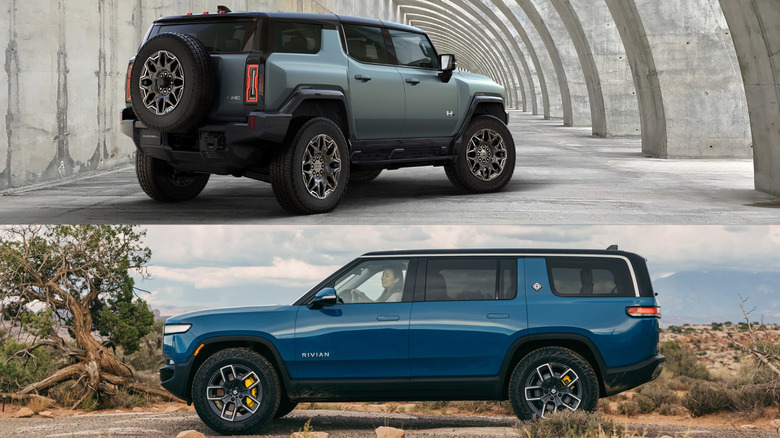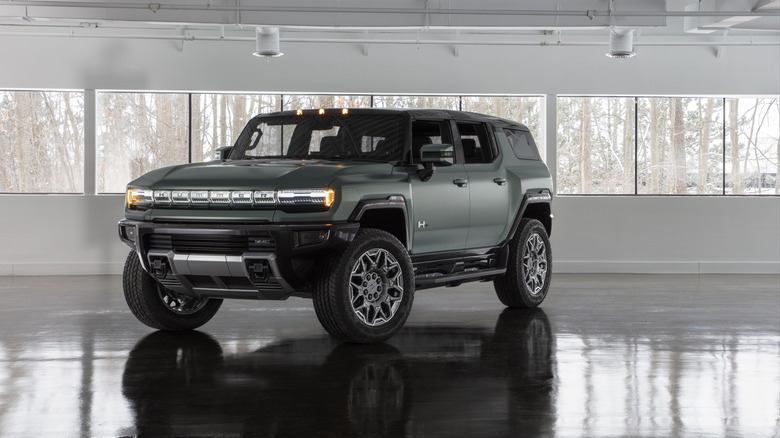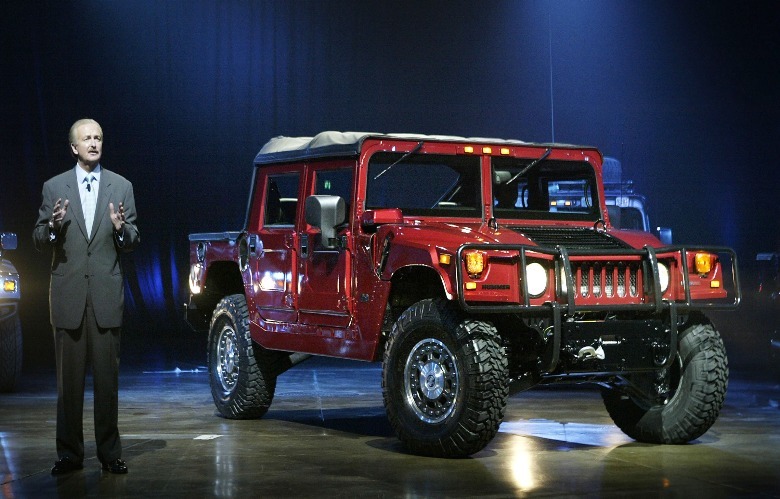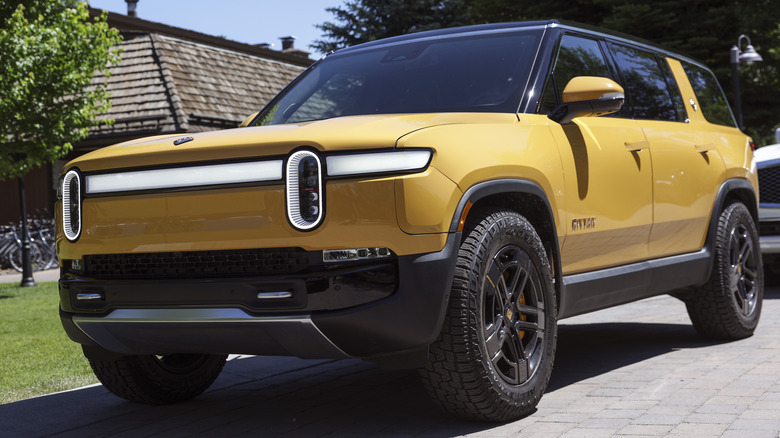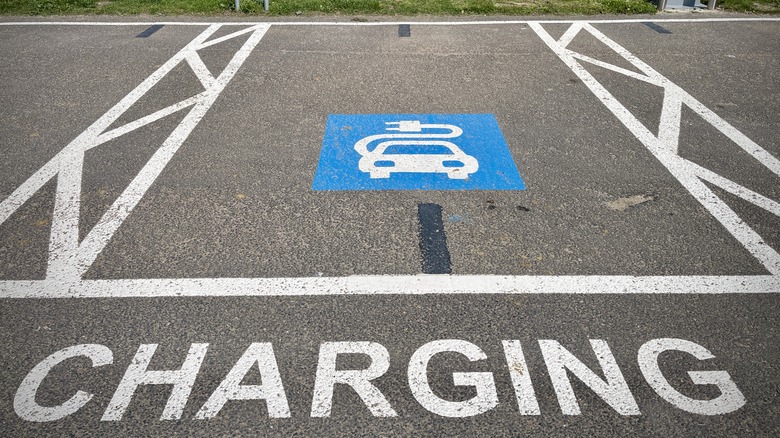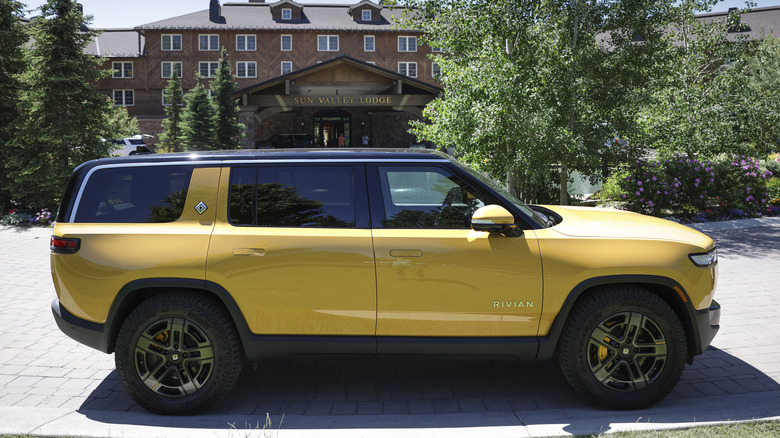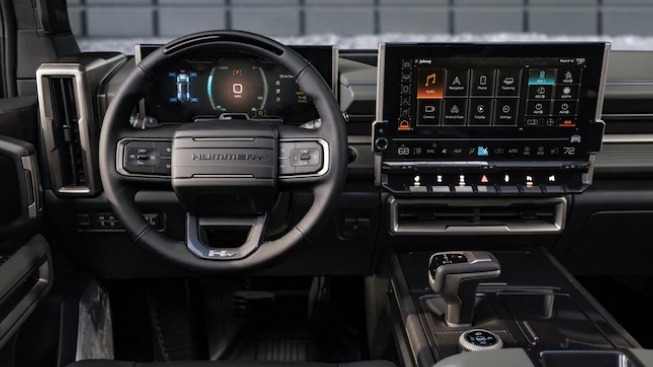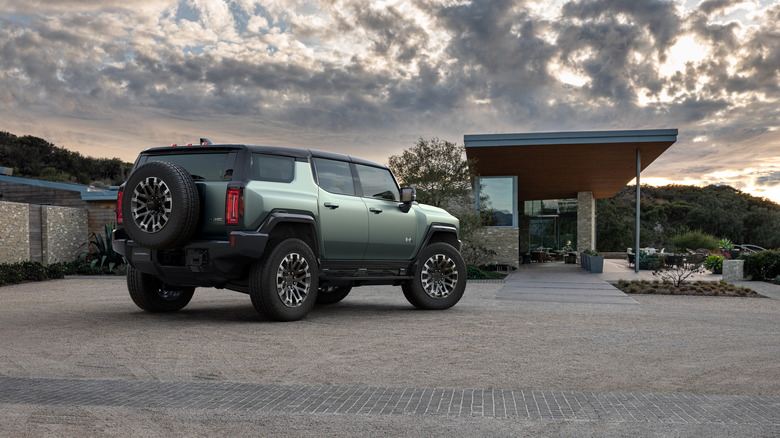Rivian R1S Vs GMC Hummer EV SUV: Which Is The Better Electric SUV?
The revealing of the Rivian R1T at the 2018 LA Auto Show, followed by Tesla's Cybertruck concept in 2019, brought a sudden interest in new, hip electric truck concepts. At the time of their announcements, however, neither brand had as much clout in the market for trucks and large vehicles as did GMC, who in 2020 announced a forthcoming electric Hummer pickup (via CNBC). In the span of three years, three EV truck concepts were set to reach the market – at some point.
With the Hummer truck beginning deliveries next year and the first Rivian R1Ts shipping to some customers in 2021, it makes sense that the two brands have stolen headlines. Their forthcoming SUV counterparts, the Rivian R1S and the GMC Hummer SUV, respectively, are very potent cousins to the electric trucks. For those who prefer the aesthetics of a fully-enclosed, but still incredibly powerful, four-wheel-drive vehicle, deciding between the two is tricky. While what we've seen to date are pre-production versions of vehicles that are set to hit the streets in the coming years, enough information is available about the two SUVs to compare them side-by-side.
Here we break down the Rivian R1S and the GMC Hummer EV SUV to determine which is right for you.
The story behind the GMC Hummer EV
Calling GM's first electric truck a Hummer was an ironic choice from the heads of General Motors. Hummer began as a pedestrian version of the then highly-capable Humvee — the car which won the contract to supply cars for the US Military in 1983. Beyond being a symbol of American strength, these Humvees skyrocketed in popularity after their potent presence in Operation Desert Storm, furthered by Arnold Schwarzenegger's liking for the Hummers. In 1999, GM bought the rights to Hummer's pedestrian production and released a series of Hummer's for the mass markets (via NPR).
Though initially popular, these new Hummers proved to be massively impractical. Not only that, but they featured some of the worst fuel economy of any vehicle on the market. It wasn't long until the Hummer brand faced the chopping block, and it left the market in 2010.
But in 2020, it came back — only instead of being its own brand, Hummer was announced as a nameplate under GMC (and with a battery powertrain instead of its powerful gas engine). But did it keep some of the glory that its nameplate suggests it would? Or more importantly, is GMC Hummer EV SUV – scheduled for release in 2024 — enough to hold its own against the Rivian R1S?
The story behind the Rivian R1S
Much like any other EV start-up, Rivian started with a mission to produce cars that release zero emissions. Rivian's journey specifically started off as, well, not Rivian. In 2009, founder RJ Scaringe founded a company dubbed Mainstream Motors, with the goal of producing electric cars that were just as capable offroad as they were on-road (via Forbes). The name later changed to Rivian, and after major investments from Ford and Amazon, Rivian debuted concepts for two new products: the Rivian R1T and Rivian R1S.
However, Rivian once had a different vision: in 2011, Rivian launched a sporty coupe concept, which never made it past the concept stage. Nonetheless, there was a small portion in Rivian's history that could have seen the company become a sports car manufacturer rather than a truck and SUV maker.
Much like the Hummer EV SUV, the Rivian R1S is a highly capable SUV that runs on battery power. Oh, you also can't just go to a dealership for one, either: You must reserve your desired SUV online and exercise patience, as it'll take a few months, or much longer, before it reaches your doorstep. Rivian's Launch edition of the R1s is no longer offered for reservations, so if you want to reserve an R1S you'll be
Range
We'll kick off this comparison with range, which for many is the deciding factor for if an EV is right for them. This is particularly true for these vehicles, given that owners are likely to not only take them off-road at some point but into remote areas like mountain ranges and deep valleys that are hard to reach in other electric vehicles. Right off the bat, both SUVs are neck and neck, with none having a distinctly-massive advantage over the other. Let's start with the top-of-the-line models. Rivian's highest-trimmed model is the R1S Adventure with Quad-Motor AWD and a large battery pack. It starts at $90,000 before options. This gets you 316 miles of range. The SUV adds about 200 miles of range in 30 minutes with DC fast-charging capability. The R1S Launch trip is no longer available, leaving the Adventure and Explore as the models taking reservations. The Explore model comes in at a range of 300.1 miles (via EV Specifications).
Technically, the highest-possible trim for the Hummer EV SUV is the Edition 1. However, that version sold out as soon as pre-orders launched, so realistically, the top-available trim is Hummer EV SUV 3X, which sets buyers back $104,650. GMC says the Hummer EV SUV 3X comes with "300+" miles of range, which isn't exactly precise. All models come with 800-Volt DC Fast Charge Capability, except for the lowest trim, where that luxury comes as an add-on.
As for the lowest trims, that remains true. In the Rivian R1S Explore with Dual-Motor AWD with the standard battery pack you get 260+ miles of range, while in the Hummer EV2 you get 250+ miles of range. Nonetheless, with the handful of extra miles tacked onto its top trim, it's advantage, Rivian.
Performance
The Rivian R1S can't be labeled as slow, especially when it's equipped with the Quad-Motor battery pack. It boasts 835 horsepower and 908 lb-ft of torque sent to all four wheels (via Hot Cars).
The Hummer EV SUV 3X uses a tri-motor battery pack that packs 830 horsepower, which is just a little shy of Rivian's 835 horses. However, the Hummer EV 3X produces 11,500 lb-ft of torque, according to GMC's listing page. Now, to put that into perspective, that's over 7,600 more lb-ft of torque than an M1 Abrams tank, the main battle tank used in the United States.
And while if you do go to GMC's website, you will see that they do in fact market their most powerful Hummers with 11,500 lb-ft of torque, there is a massive catch to this. Though not explicitly confirmed, GM is most likely using a not-so-common method to measure this torque: by measuring the torque at the wheels, and then multiplying them by the final-drive ratios. We won't go into huge details on this, but the point is that the GMC Hummer EV SUV won't have 11,500 lb-ft of torque. Per regular metrics, estimates fall between 700-900 lb-ft of torque.
Yet again, in terms of power, the two vehicles are pretty much neck and neck, with a slight advantage for the R1S. The similarities continue when comparing the 0-60 figures of each SUV. At their peak, both Rivian and GMC say their SUVs will hit 0-60 mph in three seconds.
Interior/Exterior Design
Here is where the two otherwise fairly even-matched SUVs differentiate themselves. Looking at the interior packaging, Rivian's R1S packs three rows of seating with a maximum occupancy of seven people. Its overall length is 200.8". However, the Hummer EV SUV only has two rows and seating for five despite being longer than the Rivian R1S, with it having a length of 206.8". The R1s comes with suspension travel between 8.1 inches to 14.4 inches depending on trim. The Hummer claims 13 inches of suspension travel. When you go on Rivian's R1S's configurator, you can option your Rivian R1S with a tent that'll fit three people for $3,100. While a tent isn't an immediate option for the GMC Hummer EV SUV, it does feature a trick called "Crabwalk," which allows it to drive diagonally to clear tight objects and turns. In terms of sheer brute awesomeness, the Hummer EV SUV wins this round, despite the R1S perhaps offering more luxe amenities.
Both are marketed as adventure vehicles. It's clear from their interiors one is more rugged than the other. The Rivian's interior is smooth and luxurious, featuring a massive touchscreen and a gauge cluster. Contrast that to the Hummer's utilitarian interior, with each line ending in a sharp, boxy manner. For example, the R1S's climate vents are seamlessly integrated into the dashboard, while in the Hummer, they are massive rectangles that are impossible to miss. Nonetheless, the Hummer also has a massive touchscreen and a digital gauge cluster.
Much like the interiors, the exteriors of these two SUVs are two totally different. While the Hummer's exterior is rugged and utilitarian, the Rivian looks more like a luxurious Ford Expedition. For example, the Hummer EV features a full-size spare tire in the rear, while the Rivian sports a doughnut as a spare tire.
Final Conclusion
Typically, when comparing one EV to another, firm metrics like range help to help determine a winner, along with horsepower and performance. If too close to call, as is the case here, we must use looks and electronic gizmos to decide. Comparing these two cars, then, is like comparing a Rolls Royce Phantom to a Bentley Continental GT. Both classify under the luxury market, but while one is from a trendy young upstart that uses contemporary flare and social media marketing to attract a hip crowd, the other is built by a beefed-up stalwart with enough guts and glory in its trophy case to enshrine it in any off-road-capable hall of fame.
The GMC Hummer EV should be your pick if you're primary concerns are capability and usability. For those who need a car to get from point A to point B — with a camping trip in the middle of all of it, the Hummer will do you well. Despite being a massive SUV, it has a 126.7-inch wheelbase which makes it competent offroad, and the raw power is sure to give you a thrill even on-road. The Rivian R1S won more comparisons here, and tops that off with a more stylish aesthetic and a sleeker interior. It's got two more seats than the Hummer EV SUV, and is simply more luxurious. It's also slightly cheaper and will be out slightly sooner, making for an extra nudge in the direction of the R1S.
